Introduction
In the realm of industrial machinery, efficiency and durability are paramount. Among the crucial components that ensure smooth operation are machinery teeth. These small but mighty parts play a significant role in various types of equipment, from excavators to milling machines. This article delves into the intricacies of machinery teeth, exploring their functions, types, materials, and maintenance requirements.
Functions of Machinery Teeth
Machinery teeth serve several essential functions that are integral to the efficient operation of heavy equipment:
- Cutting and Digging: In equipment like excavators and backhoes, teeth are designed to cut through tough materials such as soil, rock, and asphalt.
- Grinding and Milling: Teeth used in milling machines and grinders are crucial for grinding and milling operations, where they grind materials into finer particles.
- Tearing and Shredding: Equipment used for forestry and land clearing rely on teeth to tear through vegetation and shred wood effectively.
Types of Machinery Teeth
The type of machinery teeth used depends largely on the specific application and the type of material being processed. Some common types include:
- Bucket Teeth: Found on excavators and loaders, bucket teeth are designed for digging and loading applications. They come in various shapes and sizes depending on the material being handled.
- Cutter Teeth: Used in road milling machines and grinders, cutter teeth are specialized for grinding and milling operations. They are designed to withstand high impact and abrasion.
- Stump Grinder Teeth: These are used specifically for stump grinders to effectively grind tree stumps and roots.
Materials Used
The materials used in machinery teeth are chosen based on their hardness, toughness, and resistance to wear and abrasion:
- High Carbon Steel: Commonly used for its hardness and durability, especially in applications requiring cutting and digging.
- Alloy Steel: Provides excellent toughness and resistance to wear, making it suitable for heavy-duty applications.
- Tungsten Carbide: Known for its extreme hardness and wear resistance, tungsten carbide is often used in high-performance cutter teeth.
Maintenance and Replacement
Proper maintenance is crucial for extending the lifespan and maximizing the efficiency of machinery teeth:
- Regular Inspection: Inspect teeth for wear and damage regularly, and replace them when they show signs of wear beyond acceptable limits.
- Sharpening and Repair: Sharpen dull teeth to maintain cutting efficiency. Repair or replace damaged teeth promptly to prevent further damage to the equipment.
- Cleaning and Lubrication: Keep teeth clean and well-lubricated to prevent corrosion and reduce friction during operation.
Conclusion
Machinery teeth are indispensable components in various types of industrial equipment, playing critical roles in cutting, grinding, and tearing operations. Understanding their functions, types, materials, and maintenance requirements is essential for ensuring optimal equipment performance and longevity. By choosing the right type of teeth and maintaining them properly, industries can enhance efficiency, reduce downtime, and achieve greater productivity in their operation
Don’t share sensitive info. Chats may be reviewed and used to train our models.Learn more





